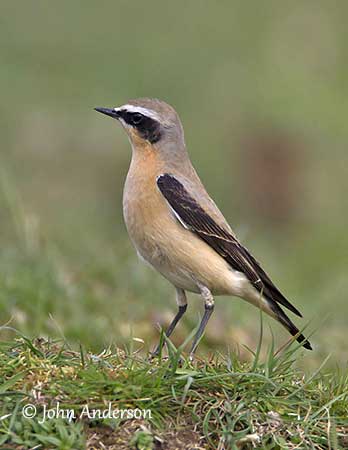
Fr: Traquet motteux
Ang: Northern Wheatear
All: Steinschmätzer
Esp: Collalba Gris
Ita: Culbianco olartico
Nd: Tapuit
Sd: Stenskvätta
Photographers:
John Anderson
John Anderson Photo Galleries
José Luis Beamonte
Pájaros de España
Didier Buysse
Vision d’Oiseaux
Paul Guillet
Photos d’Oiseaux
Nicole Bouglouan
PHOTOGRAPHIC RAMBLE
Text by Nicole Bouglouan
Sources:
HANDBOOK OF THE BIRDS OF THE WORLD Vol 10 by Josep del Hoyo-Andrew Elliott-David Christie - Lynx Edicions - ISBN: 8487334725
THE COMPLETE BOOK OF BRITISH BIRDS – Written by “Royal Society for the Protection of Birds” experts - Préface de Magnus Magnusson - Michael Cady- Rob Hume Editors - ISBN: 0749509112
THE HANDBOOK OF BIRD IDENTIFICATION FOR EUROPE AND THE WESTERN PALEARCTIC by Mark Beaman, Steve Madge - C. Helm - ISBN: 0713639601
BIRDS OF THE MIDDLE EAST by R.F. Porter, S. Christensen, P Schiermacker-Ansen C.Helm - ISBN: 0713670169
ENCYCLOPEDIE DES OISEAUX DE FRANCE ET D’EUROPE – de Peter Hayman et Rob Hume - Flammarion – ISBN : 2082009920
GUIDE HEINZEL des Oiseaux d’Europe de Hermann Heinzel, Richard Fitter et John Parslow – Delachaux et Niestlé – ISBN : 2603014862
What Bird-The ultimate Bird Guide (Mitchell Waite)
Pájaros de España (JL Beamonte)
Wikipedia, the free encyclopaedia
All About Birds (Cornell Lab of Ornithology)
Migrating Northern Wheatears Go the Distance - And Pack Accordingly, by Wesley Hochachka
Evidence for the causes of the decline in Northern Wheatear Oenanthe oenanthe in NW Europe By Simon Wotton, Conservation Scientist, RSPB Conservation Science
Tiny songbird northern wheatear traverses the world - By Victoria Gill
The Amazing Migrations of the Northern Wheatear by David Hussel
Northern Wheatear
Oenanthe oenanthe
Passeriformes Order – Muscicapidae Family
INTRODUCTION:
The Northern Wheatear is a member of the family Muscicapidae that includes only Old World flycatchers. However, this species occurs on both NE and NW coasts of North America. It breeds in open rocky grounds with scattered parches of low grass for foraging, in Europe and Asia, but also in Canada, Alaska and Greenland.
The Northern Wheatear has four subspecies and all spend the winter in Africa.
Regarding both breeding and wintering ranges, we realize that this small bird is a long-distance migrant. The Northern Wheatear regularly migrates farther than the Arctic Tern by crossing seas and continents. The Canadian breeders have to cross the northern Atlantic Ocean, but they travel shorter distances than the Alaskan breeders that cross the Bering Strait, Siberia and the Arabian Desert. They raise their young in the Arctic tundra and forage for food in Africa a few months later!
The two other subspecies breed in more temperate zones, one in the southern parts of Europe and Asia, and the second one in NW Africa.
The Northern Wheatear is currently not threatened, but the population is slightly decreasing since 1980s, but not significantly.

O.o. oenanthe Male
Scotland
DESCRIPTION OF THE BIRD:
Biometrics:
Length: 15 cm
Wingspan: 29 cm
Weight: 24 g (18-33 g)
The adult male of nominate race has bluish-grey upperparts with contrasting black wings and mask. The white rump is conspicuous as soon as the bird takes off. In flight, the white tail shows black terminal band and central rectrices, forming the typical black, inverted T.
The underparts are buffy-white, mostly yellowish bull on throat and breast.
On the head, forehead and supercilium are white. The black mask is bordered below by a white line. The crown is bluish-grey. Bill, legs and feet are black. The eyes are dark brown.
The adult male in non-breeding plumage has buffy-brown back and crown, ear-coverts are washed brown, the wing feathers are conspicuously edged pale buff and the underparts are yellowish-buff.
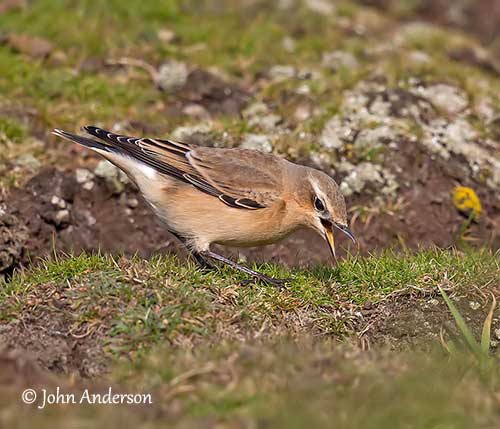
O.o. oenanthe Female
Scotland
The adult female in breeding plumage resembles male, but she has mostly pale brownish-grey upperparts instead of bluish-grey, duller head pattern and grey-brown wings.
In non-breeding plumage, she has pale buff-brown upperparts, the wing feathers are edged buff and white, the supercilium is buffy-white and the ear-coverts are brownish-rufous. The underparts are buffy-white.
The first winter is similar to female. The juvenile is similar too, but the upperparts are speckled buff and the underparts are scaled brown.
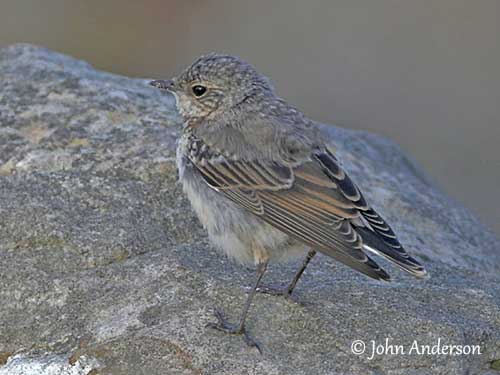
Juvenile
Scotland
SUBSPECIES AND RANGE:
The Northern Wheatear has four recognized subspecies.
O.o. leucorhoa breeds in NE Canada, Greenland, Iceland, Jan Mayen and Faeroe Islands. It winters in W Africa (Senegal and Sierra Leone, E to Mali).
This race is larger and brighter than nominate, with orange breast, pure white forehead and darker bluish-grey upperparts (tinged brown in summer males). The females are more richly coloured too.
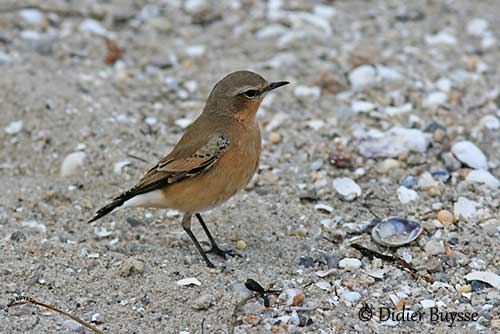
O.o. leucorhoa
French W coast
September
O.o. oenanthe (described above) breeds in N and C Europe and in N Asia, E to E Siberia and NW North America (Alaska, NW Canada). It winters in N and C Africa.
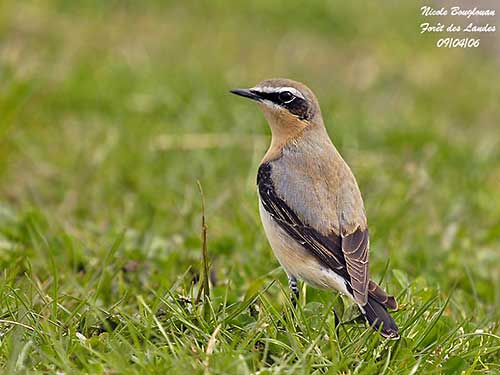
O.o. oenanthe Male
SW France
Spring
O.o. libanotica breeds in Spain and SE Europe to the Middle East and N China. It winters in N Afrotropics and Mesopotamia.
This race is almost white below in spring, and females are a duller version of males. The bill is longer and the terminal tail band is narrower.
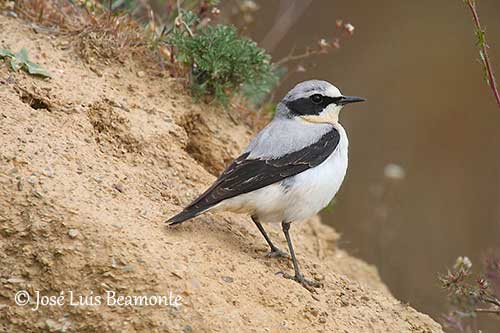
O.o. libanotica Male
Spain
O.o. seebohmi (not displayed) breeds in NW Africa and winters in W Africa in SW Mauritania and Senegal.
This race has larger mask with black throat and ear-coverts to neck sides, and blacker underwing-coverts. Some females may have pale throat.
HABITAT:
The Northern Wheatear breeds in tundra, rocky fields, upland grassland with low vegetation, barren hillsides and mountainsides, locally cliff-tops, sand dunes and islands.
During migration, it frequents a large variety of open country from farmland and pastures to desert, seashores and human settlements.
On the African wintering grounds, it can be seen in short-grass steppe and savanna, cultivated areas, rocky hills and coconut plantations.
This species may occur up to 3000 metres of elevation in Europe and Iran, and up to 3500 metres in Russian Altai.
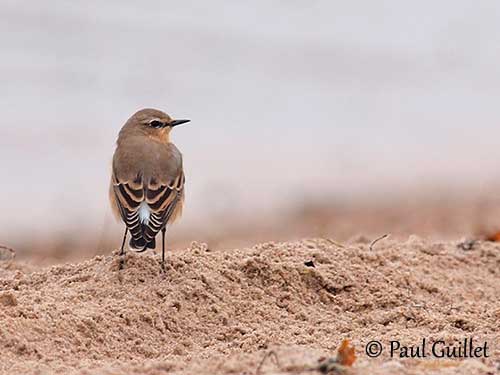
Finland
Autumn
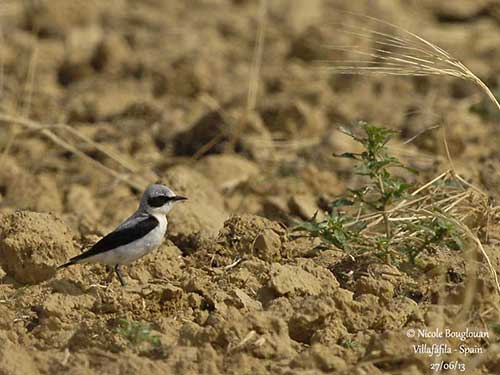
O.o. libanotica Male
Spain
CALLS AND SONGS: SOUNDS BY XENO-CANTO
The Northern Wheatear’s typical calls are a hard “chak” and a sharp “wheet”, sometimes combined as “wheet-chak-chak” in alarm.
The song is often given from perch. It is a short outburst of fast, scratchy warbling mixed with creaking notes, harsh “chak” and high-pitched, fluty whistles, usually delivered in irregular rhythm. The song may include mimicry of other bird species.
Similar song, although richer and more varied, is given during the aerial displays while the bird flies high into the air with rapid wingbeats, “dance” at top of the ascension before to descend to the ground.
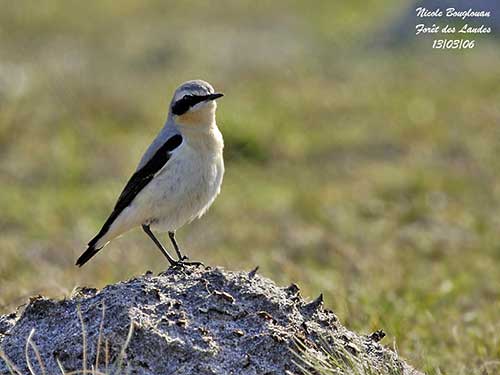
O.o. libanotica Male
SW France
Spring
BEHAVIOUR IN THE WILD:
The Northern Wheatear forages mainly on the ground, hopping and running, then stopping with erect body and wagging tail, and picking up food items. It may pursue insects in the air with fluttering flight. It also watches for preys from perch and flies down onto the prey on the ground. The feeding behaviour is closely related to each habitat structure.
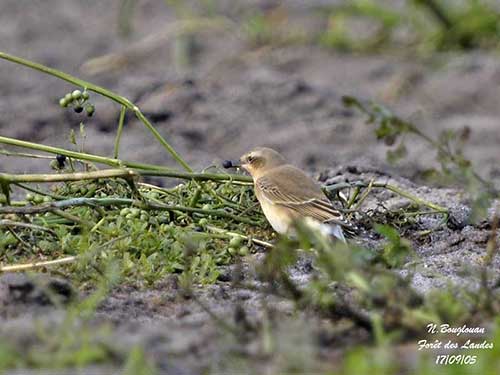
O.o. oenanthe Male
SW France
Autumn
It feeds primarily on arthropods, insects such as beetles and ants, other invertebrates and berries. It feeds on adults and larvae of numerous insects’ species, large insects, spiders, small snails and earthworms. In autumn, it feeds on berries from several plant species.
The Northern Wheatear has similar diet on the wintering grounds where it is often attracted by burnt areas with ants and termites. It often defends a small feeding territory against other wheatears.
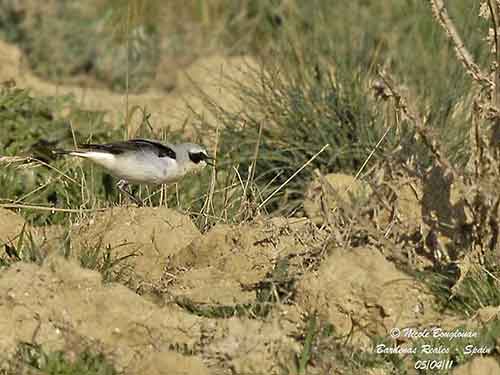
O.o. libanotica Male
Spain
Spring
During the breeding season, the male sings to defend the territory, and performs aerial displays while singing. The courtship displays on the ground often enhance the black-and-white tail pattern and the white rump.
During one display, the female crouches on the ground while the male leaps rapidly back and forth above her with spread wings and tail.
Another display shows both adults performing a courtship dance in a shallow depression in the ground, when the male flutters and glides in the air while singing.
The female chooses the nest-site as soon as the pair-bond is established. They are monogamous at least for the first brood. They may be polygynous in the second brood, and usually between neighbours.
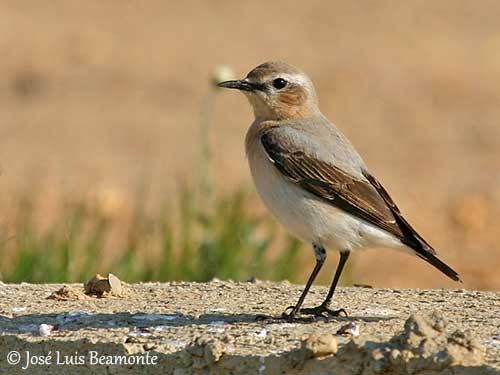
O.o. libanotica Male
Spain
The Northern Wheatear is a long-distance migrant, and travels mainly by night but also by day. The four subspecies spend the winter in Africa.
The birds breeding in Alaska and NW Canada travel about 15,000 km, crossing the Bering Strait, Siberia and Arabian Desert, with an average 290 km/day.
The NE Canadian breeders perform a shorter migration of about 7,500 km, but they have to cross the northern Atlantic Ocean over 3500 km, from extreme E Newfoundland to Azores, and then to W Africa.
The two southernmost subspecies travel usually overland to their wintering grounds.
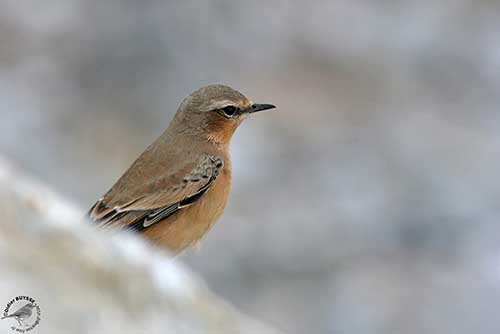
O.o. leucorhoa
French W coast
September
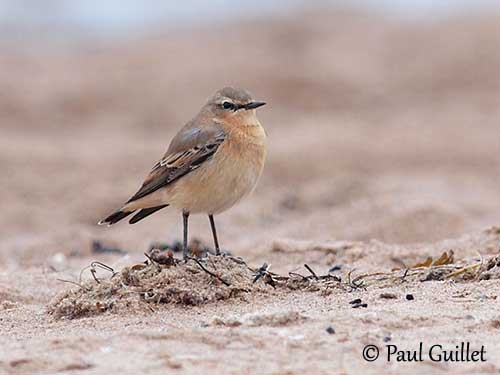
Finland
Autumn
The Northern Wheatear performs relatively slow, direct flight with shallow wingbeats. In flight, the typical black T of the tail is conspicuous like the white rump.

O.o. libanotica Male
Spain
Spring
REPRODUCTION OF THIS SPECIES:
The breeding season varies depending on the range, with the two extremes: between April and June in NW Africa, and late May/June in Iceland. The Northern Wheatear usually produces two broods in the southern parts of the breeding range, but it is single-brooded in Arctic regions.
The Northern Wheatear nests on the ground, in hole under rock, in rock crevice or among large stones, but also in abandoned rodent burrow. The nest is built by the female and placed inside this shelter. It is an open cup made with leaves, stems, moss, feathers and hair, placed on foundation of dried stems and grasses. The cup is variably lined with softer material or unlined.
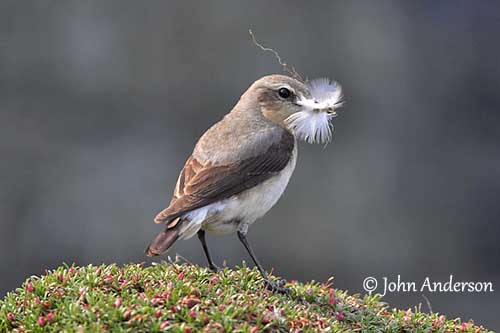
O.o. oenanthe Female
Scotland
The female lays 4-8 pale blue eggs with pale brown markings on the larger end (5-8 in Alaska, and 4-6 in NW Africa). The incubation lasts 12-14 days and is shared by both adults, but mainly by the female. The downy chicks are fed by both parents and fledge about 15-17 days after hatching. They depend on adults for food for 12-13 days after fledging. They start to breed at one year.
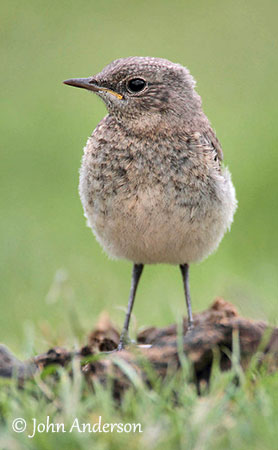
Juvenile
Scotland
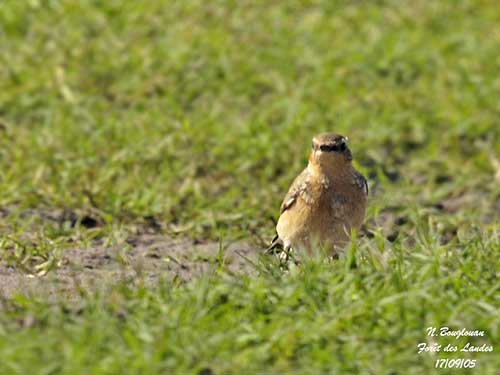
O.o. oenanthe
Moulting
SW France
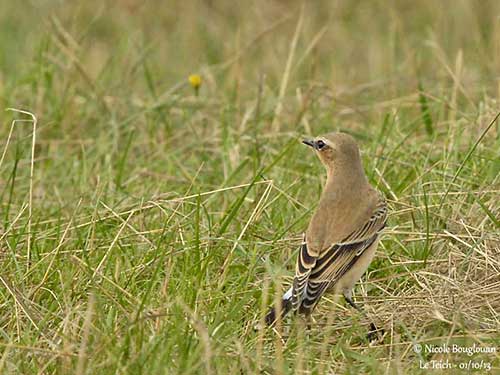
O.o. oenanthe
Autumn
SW France
PROTECTION / THREATS / STATUS:
The Northern Wheatear is abundant and widespread throughout the range, but the population is slightly decreasing, especially in many European countries. They are threatened by habitat loss due to agriculture expansion, and human developments.
The European population is estimated to number 13,800,000/39,000,000 individuals (BirdLife International 2004). As Europe forms 25-49% of the global range, a preliminary estimate of the size of the global population is 28,200,000/156,000,000 individuals. But more information is needed.
The Northern Wheatear is currently evaluated as Least Concern.
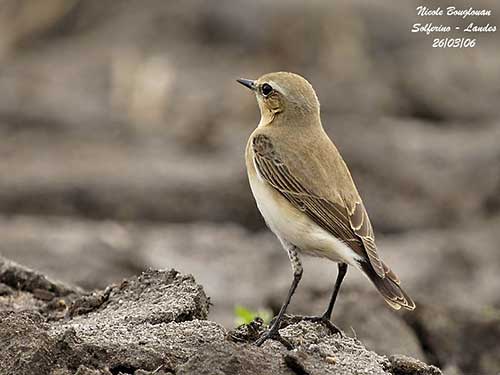
O.o. oenanthe
Spring
SW France